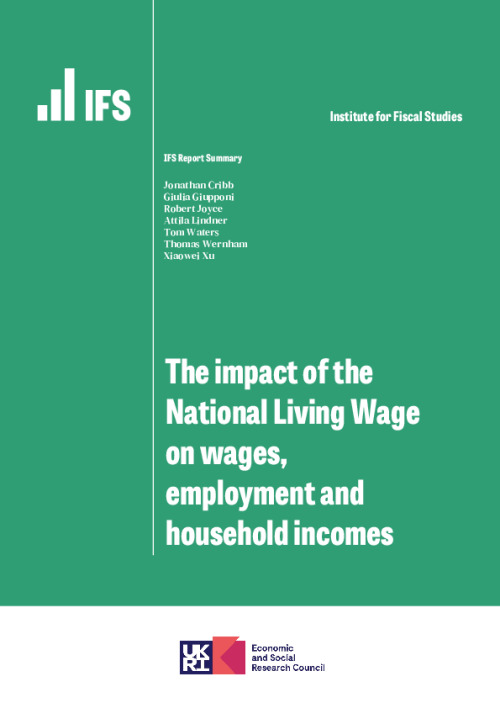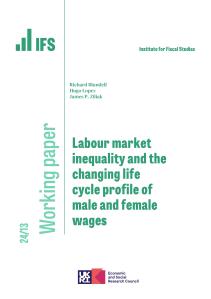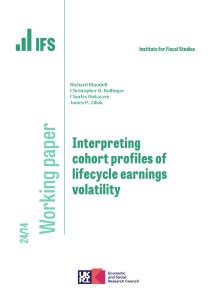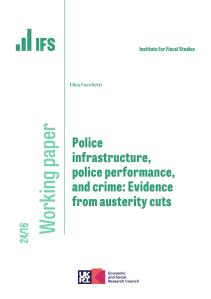The National Living Wage (NLW) is currently the government’s flagship policy aimed at helping the low-paid in the UK. It was introduced in 2016 and has been increased in each year since. In its first four years, it led to an increase in the ‘bite’ of the minimum wage (defined as its level as a fraction of the median wage) for those aged 25+ that was greater than the increase over the whole 16-year period prior to that, since the national minimum wage was introduced in 1999. This brings the UK close to the international frontier of minimum wage levels. The UK government has set a target to go further, reaching two-thirds of median wages by 2024, while incrementally extending the NLW to workers aged 21–24. In this research, we examine the effects that the NLW has had on wages, employment, and households’ incomes after accounting for taxes and benefits. Our analysis covers the period between the introduction of the NLW and the last pre-pandemic uprating – that is, 2015–19.
To study the impacts of the NLW on individuals’ wages and employment, we develop a new approach which combines key features of previous methods. We estimate the impacts of the NLW on the number of jobs paying within each wage band, meaning that we jointly capture both employment and wage effects in a single, internally consistent framework. This follows the ‘bunching’ approach recently pioneered outside of the UK by Harasztosi and Lindner (2019) and Cengiz et al. (2019). To identify these impacts, we build on a long line of empirical minimum wage research, stretching back to Card (1992), that has exploited differences in wage levels between different parts of the country. These create different degrees of exposure to the minimum wage for otherwise-similar groups of workers living in different places, even with a nationally set minimum wage. No area is completely unaffected by the minimum wage so, as with all studies that exploit regional wage variation, this delivers estimates of the effect of the minimum wage in lower-wage areas relative to higher-wage areas. We report those effects in this summary. As we explain in the accompanying working paper (Cribb et al., 2021), with additional assumptions one can use the relative estimates to extrapolate an estimated ‘absolute’ or ‘total’ effect across the nation as a whole. This turns out to be slightly larger than, but very similar to, the relative effects, reflecting the comparatively minor exposure of the highest-wage areas to the minimum wage.
To study the impacts of the NLW on the distribution of household incomes, we apply another new approach. We exploit the detailed estimates of the impacts on the labour market described above, accounting for both any employment effects and spillover effects onto those with higher wages. We simulate those effects within household survey data combined with the IFS tax and benefit microsimulation model, TAXBEN, to account for interactions between wages, taxes paid, and benefits and tax credits received.
Key findings
We find that the National Living Wage and its upratings had substantial effects on wages towards the bottom of the distribution. Averaging across the four increases to the minimum wage for those aged 25+ that we consider (i.e. in April of 2016, 2017, 2018 and 2019), we estimate that each increase caused a reduction in the number of people paid below the new NLW of a magnitude equivalent to around 5.4% of employees. We find statistically significant increases in the number of jobs not only at the new NLW, but also up to around £1.50 per hour above it (approximately the 20th percentile of hourly wages) – indicating ‘spillover’ effects on the wages of some workers a little above the minimum.
Consistent with previous research from the UK, we estimate that any impacts on employment of the introduction of the NLW and its upratings were small, and not statistically significantly different from zero. Our central estimate of the average effect of each of the four increases to the minimum wage for those aged 25+ between April 2016 and April 2019 is that each increase reduced employment by 0.1% of the pre-policy workforce in lower-wage regions relative to higher-wage regions, with a 95% confidence interval spanning –0.4% to +0.2%. Hence we can rule out large effects with high confidence. The lack of a statistically significant employment effect is consistent across alternative specifications. It also holds if we consider each of the four increases in isolation, or if we examine the ‘long difference’ between 2015 and 2019, though statistical precision is reduced considerably in those cases. The ‘own-wage employment elasticity’ implied by our estimates (the ratio of the percentage change in employment for affected workers, divided by the percentage change in the average wage for affected workers) is –0.17, which is within the typical range found by studies of other minimum wage increases.
To examine whether there is evidence of adjustment in hours of work, we estimated the effect on the number of full-time and part-time jobs separately, and neither is statistically significant. The effect of the NLW on wages came mainly from its effect on part-time workers, in particular part-time women, reflecting their relatively high likelihood of being on low wages. Part-time female employees accounted for nearly half of the reduction in jobs paid below the new NLW, and of the corresponding rise in jobs paid above it.
We find some evidence of more negative impacts on the employment of women than of men. In our baseline specification, we estimate that female employment in low-paid regions fell by 0.44% relative to high-wage regions; the 95% confidence interval spans from –0.85% to –0.03%, making it just statistically significant at the 5% level. In alternative specifications, this effect consistently hovers close to the (arbitrary) 5% statistical significance level, but is sometimes a little below it and sometimes a little above.
We also examine the effects of the NLW on workers aged under 25, who were not legally affected by it. Our estimates demonstrate substantial, statistically significant positive ‘spillover’ impacts on their wages. Our central estimate of the employment effect on the group is positive but not statistically significant, with relatively wide confidence intervals due to the much smaller sample size available. Overall then, the evidence we produce suggests that this group’s wages were increased substantially and it is more likely than not that the impact on their employment rate was either positive or neutral.
We then take the estimates of the effect of the NLW on employment and wages (including spillover effects) and use them to calculate impacts on net household incomes – accounting for household composition, taxes and benefits. One important caveat to this analysis is that, given increases in firms’ wage bills, unless there is an entirely offsetting increase in productivity then there must be other adjustments – for example, to product prices or profits – and these would reduce real incomes for some households. It is therefore likely that the total effect on household incomes will be smaller than we show, with ambiguous distributional implications.
Among all households containing a 25- to 64-year-old, the biggest cash gains go to the middle of the household income distribution, who see a £1.50 per week growth in net income from each NLW increase on average. The picture is quite symmetric around that, with the bottom and top gaining similar amounts (the top and bottom 10% both see a gain of less than 35p per week). In proportional terms, the middle of the distribution still gains the most, though the bottom clearly gains more than the top measured in this way. One of the reasons that the effects are not more progressive is that poorer families see their means-tested benefits reduced (and they pay higher taxes) when their earnings increase. In the second and third deciles of the household income distribution, almost half of the increase in earnings is clawed back in this form.
Another reason why the effects by household income are not more progressive is that some of the lowest-income households have no one in paid work. When comparing the distributional effect of the minimum wage with that of other policies that target different populations, that is an important feature to account for. From the Low Pay Commission’s point of view, however, the relevant population is arguably just those in work – particularly if the minimum wage does not itself have much impact on which households are working and which are not. If we look only among households with someone in paid work before the introduction of the NLW, the impact is somewhat more progressive: each NLW increase on average raised incomes among the bottom 30% of working households by about 0.35%, with effects steadily declining above that.
Our simulation approach to estimating the effect on household incomes also allows us to demonstrate that the results are sensitive to the employment effect, the size of which is of course estimated with uncertainty, highlighting the value of our approach which attempts to incorporate any such effects in the analysis. That said, it also allows us to demonstrate that it is very unlikely that any disemployment effect was large enough to extinguish all of the gains to household income.
















